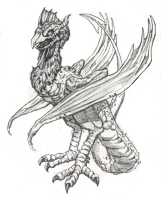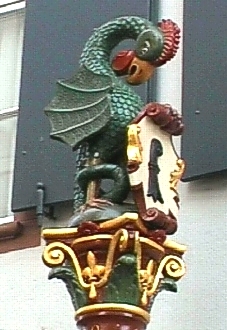Cockatrice

(Archaeocerastus sp.) A genus of wizardly fauna formerly only associated with Europe and Asia, but now also present on other continents.
Ancient and medieval peoples living in the range of the original cockatrice species were sufficiently confused about the origins of the beast that they concocted some truly bizarre stories to account for its genesis. The most popular of these, common all over Europe, was that the cockatrice hatched from a rooster's egg which had been incubated under a toad. One ancient chronicler gives this fairly detailed account:
"For they say that when a Cocke groweth old, he layeth a certaine egge without any shell, instead whereof it is covered with a very thicke skinne, which is able to withstand the greatest force of an easie blow or fall. They saye, moreover, that this egge is layd onely in the Summer time, about the beginning of the Dogge-dayes (between early July and early September), being not so long as a Hens Egge, but round and orbiculer:...sometimes of a yellowish muddy color... and afterward sat upon by a Snake or Toad, bringeth forth the Cockatrice, being halfe a foot in length, the hinder part like a snake, the former part like a Cocke, because of a treble comb on his forehead." (1)
This image of the creature is one that persists to this day in Europe, and can be seen in various coats of arms there, particularly in achievements of the arms of the city of Basel, in Switzerland. The environs of the canton of Basel-Land, close to the Black Forest and the area where present-day Switzerland, Germany and France meet, were anciently famous for being infested by cockatrices; and a pun on Basel's name is partly responsible for the other name by which the cockatrice is sometimes known in non-wizardly popular culture: the basilisk. However, in wizardly usage, the two creatures are nothing to do with one another; the cockatrice is a mutated reptilian, and the basilisk is a completely artificial construct routinely closely associated with the Lone Power.
The cockatrice is actually yet another survivor-genus of the aphthonic intervention or "rafting project" designed to save as many as possible of the indigenous wizardly life-forms of the continent of Atlantis. Not all the rafted Archaeocerastus species prospered in their new homes: most of the "westbound" species died out in North America, due to either climatic problems or conflict with local indigenous species, and had to be "replanted" later. In Europe and Asia, though, the genus had better success. Its two main species, the great crested cockatrice and northern cockatrice, are still established there -- though like many more natural species, their normal habitats are being threatened by the increasing presence of human beings in what was formerly wild or little-frequented country.
The cockatrice's most notable characteristic (all right, besides seeming to be half chicken and half snake...) is the ability to produce an effect usually referred to as broadcast neurotoxism. Small creatures on which a cockatrice fixes its gaze and attention are paralyzed: not with fear (though that would be understandable) but because the cockatrice can interfere directly with neurotransmission and other functions of the animal nervous system. This is probably another reason for the ongoing confusion with the basilisk, one variety of which (the stellate or "starry" basilisk) is able to induce tissue changes in living creatures that start out with paralysis, but emphatically don't end that way. As a result, in the popular mind both the cockatrice and the basilisk are routinely endowed with the ability to "turn things into stone", but the causes of the apparent effect are very different.
(See also: Constructs: Fireworm; mutations, wizardly.)
(1) Source of cite unknown: via Dave's Mythical Creatures and Places. (But Borges quotes Sir Thomas Browne in the 1700's re this, though without cite; also the Speculum Triplex, poss. in translation?)
